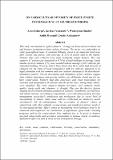| dc.contributor.author | Zeberga, Awol | |
| dc.contributor.author | Yemataw, Zerihun | |
| dc.contributor.author | Sinebo, Woldeyesus | |
| dc.contributor.author | Musemil, Sadik | |
| dc.coverage.spatial | Ethiopia | en |
| dc.date.accessioned | 2016-02-01T14:28:29Z | |
| dc.date.available | 2016-02-01T14:28:29Z | |
| dc.date.issued | 2014-03 | |
| dc.identifier.citation | Zeberga, A. et al., (2014) On farm cultivar diversity of Enset (Ensete Ventricosum W.) in Southern Ethiopia, Journal of Agriculture and Development (JAD), vol. 4, no. 1, pp. 62-85. Addis Ababa: St. Mary's University. | en |
| dc.identifier.uri | https://opendocs.ids.ac.uk/opendocs/handle/20.500.12413/8780 | |
| dc.description.abstract | This study was initiated to explore farmers ’ strategy on choice of enset cultivar mix
and features pertaining to farm cultivar diversity. The survey was undertaken on
eight geographical zones in southern Ethiopia. Enset is an important food crop,
after cereals and pulses, with coverage of 25% of arable land in the region.
Primary data were collected from enset producing sample farmers. The crop
supports 6.7 persons per household in 0.71 ha of land holdings on average. Large
number of enset cultivars (312) was recorded with an average of 10.2 cultivars per
individual holding. Diversity indices have shown that there exists high diversity of
cultivars (on the basis of local vernaculars) with few cultivars appeared to be
highly abundant with less common and rare cultivars characterize the distribution-
abundance pattern. Uneven distribution and abundance of few cultivars suggest
their relative importance and provide evidence for deliberate clonal mix for on-
farm conservation. Farmers had also prioritized and rated traits/values for
selection and maintenance of cultivars and the prime ones, among many others,
were identified. The traits comprise disease resistance, early maturity, kocho
quality, kocho yield and tolerance to drought. They are the decisive factors
shaping the distribution-abundance pattern of cultivars. Nonetheless, several biotic
and abiotic stresses, according to respondents, were confronting on-farm diversity
management, particularly production and productivity due to varied level of
susceptibility to shocks, while some cultivars celebrated for distinctive merits
encountered risk of extermination. The association of farmers’ choice of
values/traits with other cultural, socioeconomic and biophysical factors needs to
be investigated further. Efforts aimed at maintaining enset landraces need to be
enhanced and heightened via combination of approaches (gene banks, breeding
programs and in-situ conservation). Due emphasis has to be given to farmers
ascribed values/traits and resistance mechanisms to various shocks in landrace
deployment efforts as part of enset variety development strategy. | en |
| dc.language.iso | en | en |
| dc.publisher | St. Mary's University, Ethiopia | en |
| dc.rights.uri | http://creativecommons.org/licenses/by-nc-nd/4.0/ | en |
| dc.subject | Agriculture | en |
| dc.subject | Rural Development | en |
| dc.title | On farm cultivar diversity of Enset (Ensete Ventricosum W.) in Southern Ethiopia | en |
| dc.type | Article | en |
| dc.rights.holder | St. Mary's University, Ethiopia | en |


